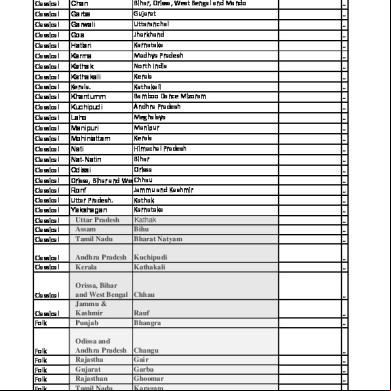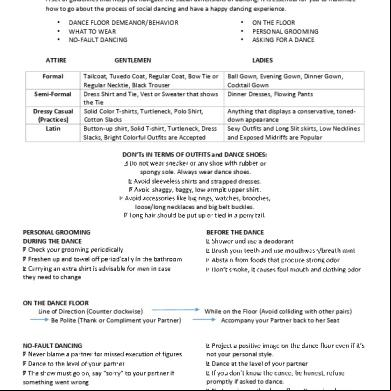Cultural Dances 3r148
This document was ed by and they confirmed that they have the permission to share it. If you are author or own the copyright of this book, please report to us by using this report form. Report 2z6p3t
Overview 5o1f4z
& View Cultural Dances as PDF for free.
More details 6z3438
- Words: 573
- Pages: 17
PHILIPPINE FOLK DANCE
MUSLIM DANCE
SINGKIL
ORIGINATED: in MARANAO people who inhabit in Lake Lanao
DESCRIPTION: It is derived from a story in SINGKIL
the Darangen, the Maranao interpretation of the ancient Indian epic, the Ramayana. The name of the dance itself means "to entangle the feet with disturbing objects such as vines or anything in your path". It is a popular dance performed during celebrations and other festive entertainment. DANCE BY: Originally only women, PARTICULARLY ROYALTY, which serves as either a conscious or unconscious ment to potential suitors. It shows the agility of the young girl turning into women with every step.
ABOUT THE DANCE: The lead dancer, in the role of Putri Gandingan (the Darangen name for Sita), graciously step in and out of closing bamboos poles arranged in either a parallel, rectangular, or criss-cross fashion while manipulating either apir (fans), mosala (scarves), or even just their bare hands.
MUSIC: play by musical instrument, a kulintang and agung. COSTUME: WOMAN (LEAD DANCER) use a muslim princess costume
ASIK
ORIGINATED: MAGUINDANAO TRIBE OF ASIK MINDANAO DESCRIPTION: Asik is a dance performed by a slave girl to win the favor of her sultan master. However, some insist that Asik is a royal dance that started with a princess dancing it to appease her sultan father. DANCE BY: a lady ABOUT THE DANCE: usually performed by the lady-in-waiting to the daughter of the Sultan. Asik usually precedes a performance of Singkil. MUSIC: play by musical instrument, a kulintang and agung PROPS: Umbrella
TRIBAL DANCE
BAGOBO (THE RICE CYCLE DANCE)
BAGOBO DANCE (THE RICE CYCLE DANCE) ORIGINATED: AGUSAN, DAVAO DEL SUR (tribe Higaonon) DESCRIPTION: is a tribal dance performed by the Bagobo people of Davao del Sur. To the Bagobo, the dance is called Miyamas neng Ommoy. Ommoy is a Bagobo term for the rice grains without husks. Portrays the step-by-step cycle rice culture; from planting, harvesting to thanksgiving rituals for a bountiful rice harvest. DANCE BY: The number of dancer actually varies. But it is usually eight girls and six boys.
ABOUT THE DANCE: Shows how Bagobos plants and process rice and cycle of it. MUSIC: The main instrument used is a tribal drum made up of animal skins COSTUME: The boys wear kneel-level pants used for farming in the field, head-band that has many colors, body band made of beads. For the girls, they wear malong, a feather head dress and necklace, made of beads. PROPS: Bamboos, Bilaos and rainmaker
RURAL FOLKS/ SA NAYON
KALAPATI
ORIGINATED: CABUGAO, ILOCOS SUR KALAPATI DESCRIPTION: It depicts the typical traits of the Ilocanos (simplicity, naturalness and shyness) DANCE BY: Girls and the number may vary ABOUT THE DANCE: is a lovely dance patterned after the characteristic movements of the kalapati or doves as they court-bowing, billing and cooing. MUSIC: Barrio music COSTUME: Dancers dress in typical Ilocano costume PROPS: no props needed
SPANISH INFLUENCE
PASEO DE ILOILO
ORIGINATED: Influence by Spanish and originate Iloilo PASEO DEinILOILO DESCRIPTION: one of the most sophisticated courtship and flirtation dances of the Spanish era. The gentlemen compete among each other to win the heart of the dalaga, or young lady, by exemplifying chivalry, grace, and confidence. DANCE BY: a lady and Gentlemen ABOUT THE DANCE: The dance used to have an elegance movement of a lady and the eagerness of two men in a mild way. COSTUME: Maria Clara suite for the lady and Barong Tagalog for men PROPS: Umbrella, fan
MUSLIM DANCE
SINGKIL
ORIGINATED: in MARANAO people who inhabit in Lake Lanao
DESCRIPTION: It is derived from a story in SINGKIL
the Darangen, the Maranao interpretation of the ancient Indian epic, the Ramayana. The name of the dance itself means "to entangle the feet with disturbing objects such as vines or anything in your path". It is a popular dance performed during celebrations and other festive entertainment. DANCE BY: Originally only women, PARTICULARLY ROYALTY, which serves as either a conscious or unconscious ment to potential suitors. It shows the agility of the young girl turning into women with every step.
ABOUT THE DANCE: The lead dancer, in the role of Putri Gandingan (the Darangen name for Sita), graciously step in and out of closing bamboos poles arranged in either a parallel, rectangular, or criss-cross fashion while manipulating either apir (fans), mosala (scarves), or even just their bare hands.
MUSIC: play by musical instrument, a kulintang and agung. COSTUME: WOMAN (LEAD DANCER) use a muslim princess costume
ASIK
ORIGINATED: MAGUINDANAO TRIBE OF ASIK MINDANAO DESCRIPTION: Asik is a dance performed by a slave girl to win the favor of her sultan master. However, some insist that Asik is a royal dance that started with a princess dancing it to appease her sultan father. DANCE BY: a lady ABOUT THE DANCE: usually performed by the lady-in-waiting to the daughter of the Sultan. Asik usually precedes a performance of Singkil. MUSIC: play by musical instrument, a kulintang and agung PROPS: Umbrella
TRIBAL DANCE
BAGOBO (THE RICE CYCLE DANCE)
BAGOBO DANCE (THE RICE CYCLE DANCE) ORIGINATED: AGUSAN, DAVAO DEL SUR (tribe Higaonon) DESCRIPTION: is a tribal dance performed by the Bagobo people of Davao del Sur. To the Bagobo, the dance is called Miyamas neng Ommoy. Ommoy is a Bagobo term for the rice grains without husks. Portrays the step-by-step cycle rice culture; from planting, harvesting to thanksgiving rituals for a bountiful rice harvest. DANCE BY: The number of dancer actually varies. But it is usually eight girls and six boys.
ABOUT THE DANCE: Shows how Bagobos plants and process rice and cycle of it. MUSIC: The main instrument used is a tribal drum made up of animal skins COSTUME: The boys wear kneel-level pants used for farming in the field, head-band that has many colors, body band made of beads. For the girls, they wear malong, a feather head dress and necklace, made of beads. PROPS: Bamboos, Bilaos and rainmaker
RURAL FOLKS/ SA NAYON
KALAPATI
ORIGINATED: CABUGAO, ILOCOS SUR KALAPATI DESCRIPTION: It depicts the typical traits of the Ilocanos (simplicity, naturalness and shyness) DANCE BY: Girls and the number may vary ABOUT THE DANCE: is a lovely dance patterned after the characteristic movements of the kalapati or doves as they court-bowing, billing and cooing. MUSIC: Barrio music COSTUME: Dancers dress in typical Ilocano costume PROPS: no props needed
SPANISH INFLUENCE
PASEO DE ILOILO
ORIGINATED: Influence by Spanish and originate Iloilo PASEO DEinILOILO DESCRIPTION: one of the most sophisticated courtship and flirtation dances of the Spanish era. The gentlemen compete among each other to win the heart of the dalaga, or young lady, by exemplifying chivalry, grace, and confidence. DANCE BY: a lady and Gentlemen ABOUT THE DANCE: The dance used to have an elegance movement of a lady and the eagerness of two men in a mild way. COSTUME: Maria Clara suite for the lady and Barong Tagalog for men PROPS: Umbrella, fan





